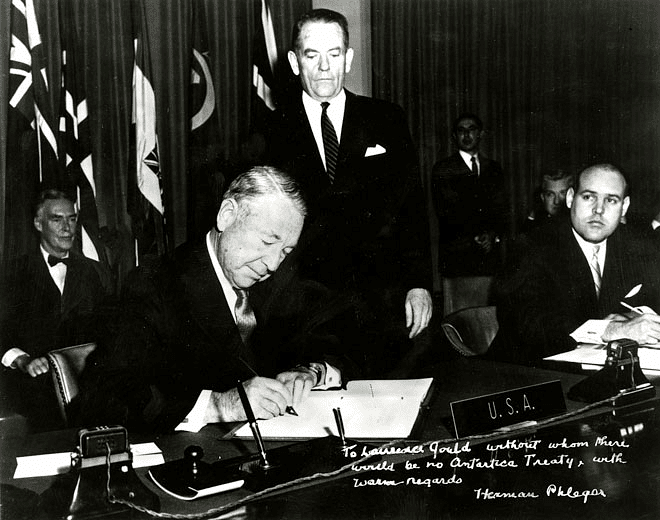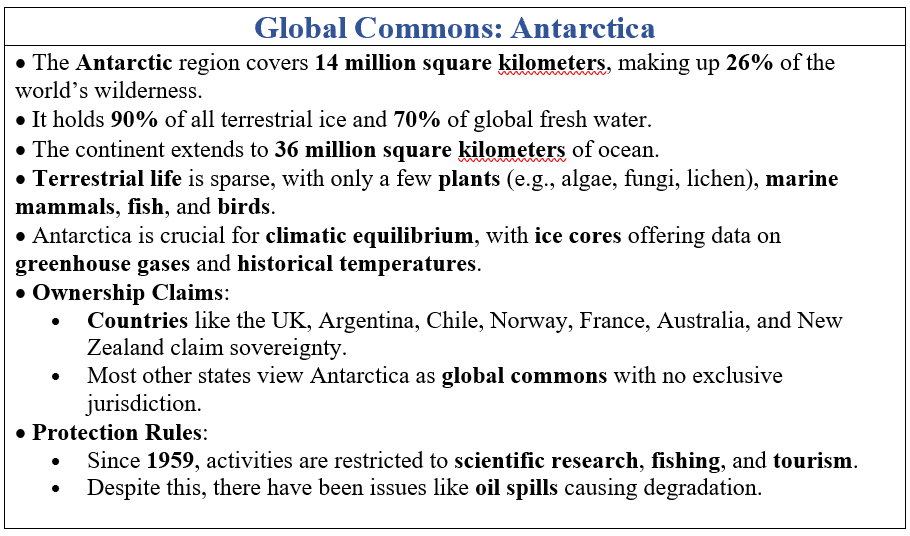Environment & Natural Resources Class 12 Political Science
Introduction
Environmental challenges like land degradation, overfishing, and water pollution are deeply intertwined with global politics. These issues highlight critical questions of responsibility and power, demanding international cooperation and solutions.

Environmental Concerns in Global Politics
- Natural forests are being destroyed, causing climate instability and displacement of people.
- The ozone hole poses threats to ecosystems and human health.
- Coastal pollution is increasing due to land-based activities affecting marine environments.
Political Dimensions:
- These issues involve questions of responsibility and power.
- Environmental degradation is a global issue requiring worldwide political involvement.
Political Questions:
- Who causes damage?
- Who bears the costs?
- Who controls resources?
Historical Context:
- From the 1960s, environmental awareness gained political significance with the publication of Limits to Growth and the rise of international environmental organizations.
Earth Summit 1992:
- Attended by 170 states; highlighted differences between the global North and global South on environmental priorities.
- Resulted in conventions on climate change, biodiversity, and forestry, and the Agenda 21 framework for sustainable development.
Criticism of Agenda 21: Criticized for prioritizing economic growth over ecological conservation, raising contentious issues in global environmental politics.
The Protection of Global Commons
 Signing of The Antarctic Treaty
Signing of The Antarctic Treaty
- Commons are resources shared by a community, not owned by anyone specifically, such as a common room, community center, park, or river.
- Global commons are regions outside any single state's sovereignty, requiring international governance. Examples include: Earth's atmosphere, Antarctica, Ocean floor and Outer space
- Cooperation over global commons is challenging due to Difficulties in achieving consensus on environmental agendas and Vague scientific evidence and time frames.
- Significant agreements include:
1959 Antarctic Treaty
1987 Montreal Protocol
1991 Antarctic Environmental Protocol - The ozone hole discovery in the mid-1980s highlighted both opportunities and challenges in addressing global environmental issues.
- Outer space management is affected by North-South inequalities, with disparities in technology and industrial development.
- The benefits of exploitative activities in global commons are uneven, impacting present and future generations differently.
 The Protection of Global Commons: Antarctica
The Protection of Global Commons: Antarctica
Common but Differentiated Responsibilities
North-South Approach Differences:
- Developed North: Advocates for equal responsibility for ecological conservation.
- Developing South: Believes that developed countries, responsible for most past degradation, should bear more responsibility for addressing it. They argue that developing countries should not face the same restrictions during their industrialization.
- Established in the Rio Declaration (Earth Summit, 1992).
- Acknowledges different contributions to environmental degradation and emphasizes that developed countries should take greater responsibility for sustainable development due to their historical emissions and technological resources.
United Nations Framework Convention on Climate Change (UNFCCC):
- UNFCCC Emphasizes action based on equity and common but differentiated responsibilities.
- Recognizes that developed countries are historically responsible for the majority of greenhouse gas emissions, while per capita emissions in developing countries are lower.
Kyoto Protocol:
- Kyoto Protocol was Agreed upon in 1997 in Kyoto, Japan.
- Sets targets for industrialized countries to reduce greenhouse gas emissions.
- Exempts developing countries like China and India from emission reduction requirements.
- Focuses on gases like Carbon Dioxide, Methane, and Hydrofluorocarbons, which contribute to global warming and potential catastrophic consequences.
Commons Property Resources
- Common property refers to resources shared by a group where members have both rights and duties regarding their use and maintenance.
- In India, village communities have historically defined rights and responsibilities for managing common property resources.
- Factors affecting common property include privatization, which reduces the availability of shared resources; agricultural intensification, which increases strain on resources; population growth, which heightens demand and pressure; and ecosystem degradation, which diminishes the quality and availability of resources.
- An example of a common property regime is sacred groves, which are state-owned forest lands traditionally managed by village communities along the forest belt of South India.
India’s Stand on Environmental Issues

- India signed and ratified the 1997 Kyoto Protocol in August 2002.
- Developing countries like India and China were exempt from Kyoto Protocol requirements due to their relatively small historical contributions to greenhouse gas emissions.
- Critics argue that developing countries, including India and China, will soon become significant contributors to greenhouse gas emissions.
- At the G-8 meeting in June 2005, India highlighted that per capita emissions in developing countries are much lower than those in developed countries.
- India maintains that developed countries should bear the primary responsibility for reducing emissions due to their historical contributions.
- India’s international negotiating stance is based on the principle of historical responsibility, as outlined in the UNFCCC, which emphasizes prioritizing economic and social development for developing countries.
- India is concerned that new binding commitments on rapidly industrializing countries might undermine the spirit of the UNFCCC.
- Despite rising per capita emissions, India’s emissions are predicted to remain below the global average.
- The Indian government is engaged in global environmental efforts, including the National Auto-fuel Policy, Energy Conservation Act, and Electricity Act, which promote cleaner energy and improved energy efficiency.
- India is also advancing projects such as the National Mission on Biodiesel and has one of the largest renewable energy programs globally.
- In 2016, India ratified the Paris Climate Agreement.
- A review in 1997 highlighted the lack of progress in transferring financial resources and technology to developing countries.
- India believes developed countries need to provide financial support and clean technologies to help developing nations meet their commitments under the UNFCCC.
- India advocates for a unified stance among SAARC countries on global environmental issues to strengthen the region’s influence.
 Sacred Groves in India
Sacred Groves in India
Environmental Movements: One or Many?
Volunteer-Led Movements as Responses to Environmental Degradation:
- Many impactful responses to environmental degradation come from environmentally conscious volunteers rather than governments.
- These movements operate at both international and local levels and are among the most vibrant and powerful social movements globally.
Purpose and Impact:
- Environmental movements introduce new ideas and long-term visions for both individual and collective actions regarding the environment.
Examples of Environmental Movements:
- Forest Movements: Addressing deforestation in regions like Mexico, Chile, Brazil, Malaysia, Indonesia, continental Africa, and India, despite decades of activism.
- Minerals Industry: Faces criticism for its impact, including extraction, pollution, deforestation, and community displacement. Notable resistance includes opposition to the Western Mining Corporation in the Philippines.
Anti-Dam Movements: Oppose the construction of mega-dams and advocate for sustainable and equitable management of river systems. Examples include:
- The Franklin River campaign in Australia.
- The Narmada Bachao Andolan in India.
Principle of Non-Violence: Emphasized by anti-dam movements in India.
Resource Geopolitics
- Fundamental Questions of Resource Geopolitics: Involves who gets what, when, where, and how resources are allocated and controlled.
- Historical Context:
1. European Expansion: Driven by resources, leading to power expansion and interstate rivalry.
2. Western Geopolitical Focus: Historically centered on trade, war, and overseas resources, including maritime navigation. 17th Century: Securing naval timber became crucial for European powers.
World Wars: Ensuring an uninterrupted supply of strategic resources, especially oil, was critical.
Cold War: Industrialized nations used military presence, stockpiling, supporting friendly governments, and multinational companies to secure resources.
Post-Cold War: Resource security continued to be important, with a focus on radioactive materials and oil.
- Oil:
1. Central to global strategy, influencing the global economy and fueling political struggles and wars, especially in West Asia and Central Asia.
2. The Gulf region is critical, holding about 30% of global oil production and 64% of known reserves.
3. Saudi Arabia and Iraq are key players, with Iraq’s reserves potentially being larger. - Water: Increasingly crucial due to regional variations and scarcity. Potential for conflicts over shared water resources, including:
1. Disputes between downstream and upstream states over pollution, irrigation, and dam construction.
2. Historical and recent conflicts such as those between Israel, Syria, and Jordan over the Jordan and Yarmuk Rivers, and between Turkey, Syria, and Iraq over the Euphrates River.
The Indigenous People and their Rights
Indigenous populations are descendants of people who lived in a territory before the arrival of different cultural or ethnic groups, as defined by the UN.

Lifestyle:
- Indigenous peoples often live in alignment with their social, economic, and cultural customs rather than with national institutions.
Global Presence:
- Approximately 300 million indigenous people are spread across regions such as India, the Philippines, Chile, Bangladesh, North America, Panama, and the Soviet North.
- They advocate for their struggles, rights, and equal status within the global community.
Historical Occupation:
- Indigenous peoples have historically occupied areas in Central and South America, Africa, India, and Southeast Asia.
- In Oceania (including Australia and New Zealand), Polynesian, Melanesian, and Micronesian peoples have inhabited these regions for thousands of years.
Challenges:
- Loss of land and economic resources threaten their survival and political autonomy.
- In India, Scheduled Tribes are considered indigenous and make up nearly 8% of the population. They depend on land cultivation and have faced displacement due to colonial rule and development projects.
Development and Rights:
- Despite constitutional protections, indigenous people in India have faced limited benefits from development and significant displacement.
- Indigenous rights have been historically neglected in both domestic and international politics.
International Advocacy:
- In the 1970s, international contacts among indigenous leaders led to the formation of the World Council of Indigenous Peoples in 1975, the first of 11 indigenous NGOs with UN consultative status.
- Movements against globalization often highlight the rights of indigenous peoples.
Conclusion
Addressing environmental issues requires a global approach that considers resource management, indigenous rights, and historical responsibilities. Effective solutions depend on international collaboration to ensure a sustainable and just future.
|
34 videos|243 docs|52 tests
|
FAQs on Environment & Natural Resources Class 12 Political Science
| 1. What are some of the key environmental concerns in global politics? |  |
| 2. What is the concept of Common but Differentiated Responsibilities in relation to environmental issues? |  |
| 3. How does resource geopolitics impact environmental issues on a global scale? |  |
| 4. How does India approach environmental issues on the global stage? |  |
| 5. What role do indigenous peoples play in environmental protection and resource management? |  |

|
Explore Courses for Humanities/Arts exam
|

|

















